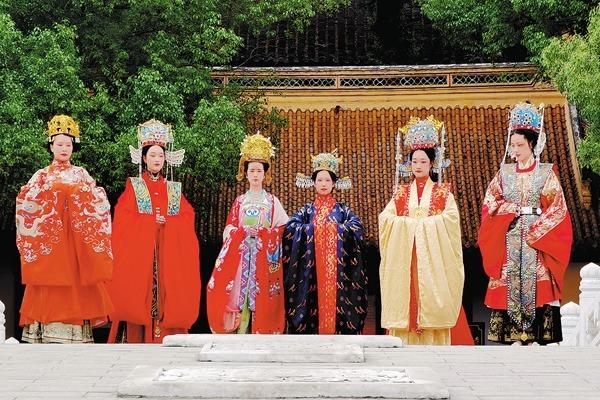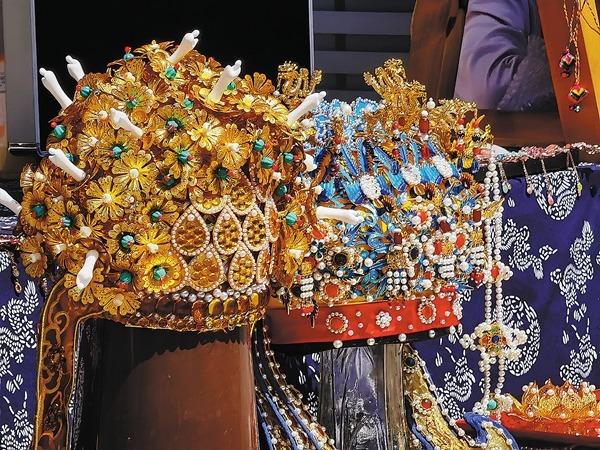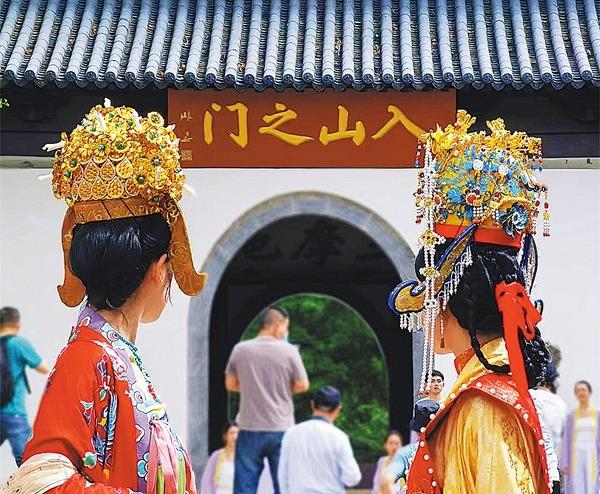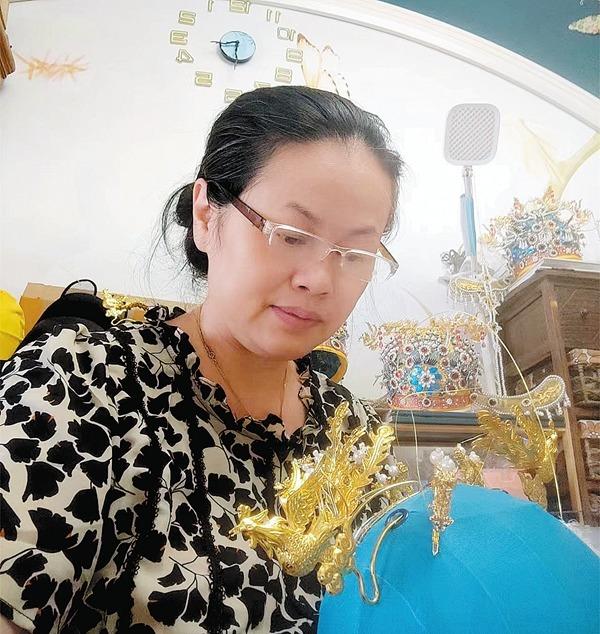 Members of the Taowu Hanfu Society don coronets made by Li Xin as they celebrate Dragon Boat Festival in the Langshan Mountain scenic area in Nantong, Jiangsu province, in June, 2022. (PHOTO PROVIDED TO CHINA DAILY)
Members of the Taowu Hanfu Society don coronets made by Li Xin as they celebrate Dragon Boat Festival in the Langshan Mountain scenic area in Nantong, Jiangsu province, in June, 2022. (PHOTO PROVIDED TO CHINA DAILY)
In ancient China, fengguan, or the phoenix coronet, was the ultimate symbol of nobility, worn by aristocratic women. In some dynasties, only queens had the exclusive right to the headpiece. The coronet usually featured elaborate accessories such as the phoenix, flowers and clouds, adorned with countless gems and dangling ornaments.
Li Xin, a resident of Zhuzhou, Hunan province, is an artisan who specializes in making the coronet. So far, the 54-year-old has made 728 pieces by hand, with some differences in each.
Apart from original designs, she also makes replicas of antique coronets, the most ornate being that of Empress Xiao, wife of Emperor Yang of the Sui Dynasty (581-618).The crown was unearthed in Yangzhou, Jiangsu province, in 2013. It took experts more than two years to restore the heavily corroded artifact.
 Replicas of phoenix coronets made by Li, including that of Empress Xiao (left). (PHOTO PROVIDED TO CHINA DAILY)
Replicas of phoenix coronets made by Li, including that of Empress Xiao (left). (PHOTO PROVIDED TO CHINA DAILY)
This year, Li was commissioned by the Taowu Hanfu Society, an organization that promotes hanfu (a traditional Chinese attire) in Nantong, Jiangsu, to make a replica of Empress Xiao's crown to serve as a prop in shows.
Li says this was the most difficult piece she has made. "I had to figure out many details by searching for material online."
Li adds that "no one has seen how Xiao's coronet looked like in its prime. People might have their own ideas about it. I want the replica to be as splendid as possible."
Li started by making a single petal. The coronet has 13 flower clusters, with each cluster comprising 24 flowers, each flower formed by six petals, and each petal decorated by six pearls. By referencing the official replica of the headgear and adding details, Li spent more than two months to finish the coronet, using around 5,000 pearls and more than 600 gems.
ALSO READ: Remembering Lao She
 Members of the Taowu Hanfu Society don coronets made by Li Xin as they celebrate Dragon Boat Festival in the Langshan Mountain scenic area in Nantong, Jiangsu province, in June, 2022. (PHOTO PROVIDED TO CHINA DAILY)
Members of the Taowu Hanfu Society don coronets made by Li Xin as they celebrate Dragon Boat Festival in the Langshan Mountain scenic area in Nantong, Jiangsu province, in June, 2022. (PHOTO PROVIDED TO CHINA DAILY)
When making coronets, Li insists on following the ancient technique of threading the pearls and gems, rather than gluing them on the settings. The craft is complicated, involving a lot of different techniques. A single technique could take up to a year to master.
Li herself started learning embroidery and a few other crafts from her grandmother at the age of 4. When she grew up, Li worked at the Zhuzhou railway bureau, she never gave up honing her handicraft skills
Li herself started learning embroidery and a few other crafts from her grandmother at the age of 4. When she grew up, Li worked at the Zhuzhou railway bureau, she never gave up honing her handicraft skills.
"Back then, the bureau often hosted stage performances for the rail staff, and I was responsible for making all the props and headpieces in the styles of various ethnic groups," Li says.
With the experience, she then set her heart on making "the ultimate ornament", a coronet.
"To have something you love is terrifying. Because once you find it, you'd be willing to give it your all," she adds.
Chen Yinlong, president of the hanfu organization, says: "There are many ways to make coronets nowadays, using machines, or even 3D printers. If one doesn't observe them closely, they might not see any difference. But these are not what we want.
READ MORE: Spreading beauty
 (PHOTO PROVIDED TO CHINA DAILY)
(PHOTO PROVIDED TO CHINA DAILY)
"Li has the true spirit of artisans. When it comes to her creations, she never takes a perfunctory attitude, or makes do with something inferior. She is really doing her best to replicate the originals with patience. We admire her for that."
Li now runs her own studio, where she makes the old-style headpieces while teaching the craft to those who are interested. Her son is one of her students, who also helps her run the studio's social media accounts.
Young people who take an interest in making coronets and in traditional culture are a source of inspiration for her.
"Now a lot of young people wear hanfu. I find it so beautiful, and it's such a wonderful thing that we should be confident in our own culture," she says. "It would be my greatest achievement if I could pass down this traditional craft. We, as the older generation of artisans, have the obligation to pass it on, otherwise, the younger generation wouldn't be able to inherit it."



